Steve Says:
My traveling companion and I have fallen in love with remote places on islands on each Canadian coast that we’ve visited in the off-season.
To reach Tofino, on the Pacific coast of Vancouver Island, we have traveled by plane to Victoria, by ferry to Sidney, both about a six-hour drive from Tofino, and by ferry to Nanaimo, a four-hour drive. All three routes, you spend about two hours winding through the mountains on a narrow but spectacular old logging road. Piggybacking on my professional travel to British Columbia or Washington state, we have visited in January (twice, including our first visit), December, November, October and September. Our only summer visit, in August, was our only visit purely on personal travel, for our 30th wedding anniversary.
We’ve visited Nova Scotia four times now, but didn’t make it to Cape Breton on our first three visits. We had enjoyed the capital city of Halifax and the nearby Lighthouse Route on our earlier trips.
My companion loves the ocean and I love the mountains, and I knew Cape Breton would be a favorite (Canadians would say favourite) of both of ours. While we both enjoyed the Lighthouse Route on Nova Scotia’s southern shore, the Atlantic’s waves there were not as raucous as Pacific waves that enchanted her in Tofino. She’s an Iowa farm girl who can’t get enough of the ocean. I thought the eastern shore of Cape Breton might provide more crashing waves. Not to mention cliffs and mountain vistas. I spent five years growing up in Utah and fell in love with mountains and canyons.
When I was invited to speak this month to a conference in Halifax, I wanted to be sure to take the time to visit Cape Breton and its Eastern shore. Mountains for me, crashing waves for her. That sounded like an ideal vacation. Even if that meant a lot of driving. And it did.
As I scouted online for places to stay, I noticed that some places wouldn’t be opening until later in May. But the Castle Rock Inn in Ingonish Ferry was open, promising ocean views.
No airline has a direct flight from Dulles to Halifax, so our best option was to connect through Newark, arriving at about 4 p.m. Atlantic time (the Maritimes are an hour later than the Eastern time zone). We rented our car and headed off to Ingonish, about five hours away.
Knowing we were going to be arriving in the dark, we didn’t want to stop long for food, so we went with fast food in the town of Antigonish. We would have time for Atlantic seafood later. I was thinking a large order of fries and a drink would do. But when my companion saw the McLobster sign, she ordered one for each of us. Let’s just say it was every bit as satisfying as a McRib. I did not make the rest of the ride as long for her as I could have. But as George Costanza would say, I had hand (really, Buttry, you’re invoking Costanza here? I thought I should say that before she does). Whenever the conversation started to tilt to her advantage, a simple mention of McLobster restored order.
About three hours into the drive, our first views of open water, the Northumberland Strait north of Nova Scotia’s mainland, told us we were approaching the Canso Causeway. We drove across the causeway to Cape Breton (no ferry needed to reach this island, though we did see signs for ferries to Prince Edward Island and Newfoundland).
As the sun set behind us, we continued up Cape Breton, driving along the western shore of Bras d’Or Lake, the inland sea that separates the two arms of Cape Breton. It was fully dark by the time we left the town of Baddeck. Soon a sign warned that we wouldn’t encounter a gas station for the next 50 kilometers (a reminder of the warning on that Vancouver Island logging road that we wouldn’t see another gas station for another 85 kilometers). I checked the gas gauge (no problem) and the odometer. My lights were on bright.
Here’s proof that we had arrived before tourist season: I didn’t dim my lights for more than half of that 50 kilometers (or kilometres, as they spell it in Canada) along the darkened Cabot Trail.
My passenger was sure we were near the ocean. Yes, I agreed, that heavy fog enveloping the road might be an indication we were near water. Signs warned us to watch for moose and I was pretty sure I saw one along the roadside at each hairpin turn of the road, though none actually appeared.
It was after 9 p.m. when we nearly drove past the driveway for the Castle Rock Country Inn, the decorative sign difficult to read in the dark and fog. Innkeeper Kim Magistro checked us in and before long we were sleeping.
We woke to a view of the ocean and Middle Head peninsula out our window. My roommate could see waves crashing on the tip of the peninsula. We both wanted a closer look. Kim suggested a hike along the peninsula for the morning, followed by a drive on the Cabot Trail to the other side of Cape Breton. There we might enjoy lunch at an Acadian restaurant in Chéticamp, about a two-hour drive away.
After filling the car with gas, we drove into the Cape Breton Highlands National Park and turned east toward the Keltic Lodge on Middle Head. After parking near the trailhead, we read signs warning that we might encounter bears, moose or coyotes. My companion fetched us each one of the walking sticks leaning against a stone gatepost, as though we would be able to fight off a bear with a walking stick.
We set out along the trail. For an hour or so, we hiked the trail, enjoying occasional views of the Castle Rock Inn above the cliff across the bay. At several points along the path, we sat on benches to enjoy particularly scenic views of the ocean below. At its narrowest point, we could see ocean on both sides, with waves crashing on the rocks below. As a younger man, I might have climbed down to the rocks for a closer look. But in middle age, I reveled in the view from above.
We completed the hike without any need for the walking sticks and left them leaning against the stone gatepost for the next hikers.
The drive up the eastern coast along the winding Cabot Trail provided frequent breathtaking views of towering cliffs across a bay or inlet, with crashing waves below. Mountains rose to the west, with creeks cascading down in more waterfalls than we could count. We made slow progress, taking advantage of every parking area offering a scenic overlook.
On Vancouver Island, we enjoy walking the expansive sandy beaches. On Cape Breton, the one time we ventured down to the water, the shore was rocky, like a beach of fist-sized marbles. Walking was treacherous and I gave up trying to get close enough to shoot a good picture of the waterfall at the other end of the beach.
Occasional signs told us to watch out for moose. Not as intimidated in daylight, I explained to my companion that this was our division of labor: I would drive, she would watch for moose. I was doing my job much better than she did hers, a fact I noted from time to time. To her credit, she did point out two bald eagles on the drive, one in a marshy area along the coast and another flying near the road.
At the little town of New Haven, the Cabot Trail turned west and we drove through the mountains to the Acadian side of the island. The woods were dry, just starting to green up, though easily half the trees were evergreens. The mountains were not as dramatic as in Utah or Vancouver Island or as Cape Breton itself must be in the fall, but it was a beautiful ride, relaxing even with its steep climbs and sharp turns. Before long we were on the western shore, looking down on the Gulf of St. Lawrence. The cliffs on this side provided still more spectacular views.
At Chéticamp, we stopped at Le Gabriel, which sounded like it should offer Acadian food. The menu confirmed that it did offer Acadian dining. But the waitress explained that the Acadian fare would not be offered until tourist season started in a few weeks. We settled for (and enjoyed) fish and chips.
Rain fell on our drive back, reinforcing that we had made the right choice to hike in the morning. My companion still had not found a moose, so I took matters into my own hands – or eyes – on the return trip down the eastern shore, spotting a huge cow moose in the thinning woods on the left side of the road. After driving past, we turned around for another look. We didn’t see it on the second pass, but it was visible again on the third pass. I stopped long enough for my companion to snap a photo. She weakly claimed credit for the second sighting.
A little later, a mink scampered across the highway in front of us. I was pretty sure it was a mink, but my companion wondered if it might be some other kind of weasel. I insisted it was a mink, and when we got back to Castle Rock, a quick web search for mink photos confirmed my sighting. She tweeted that this would be the closest she would come to getting a mink from me. Here, I had to admit that she was right.
She did, however, buy a blanket from Tartans and Treasures for our living room rocking chair and a floppy hat from Sew Inclined to wear walking her dog. When you visit in the off-season, you want to reward the merchants who stay open year-round or at least open early.
Our day closed with a pleasant seafood dinner at the Castle Rock’s Avalon restaurant, looking out again on Middle Head and the Atlantic.
Thursday’s drive back to Halifax confirmed what we had suspected Tuesday night and were pretty sure after Wednesday’s drive: The darkness and fog had obscured spectacular views of cliffs and waves on the drive between Ingonish and Baddeck. We didn’t even mind making a wrong turn. That just meant a few more minutes soaking in the scenery.
Cape Breton hasn’t displaced Tofino as our favourite destination. But on either of Canada’s coasts, we think the mountains and oceans reward those with the patience for a long drive.

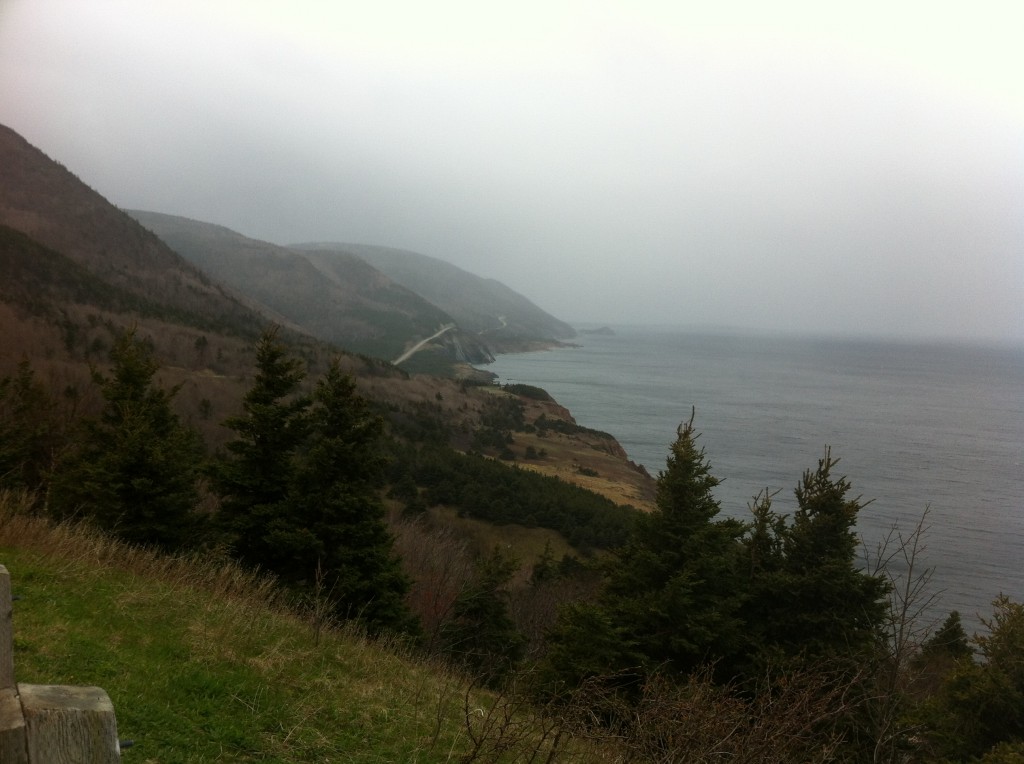
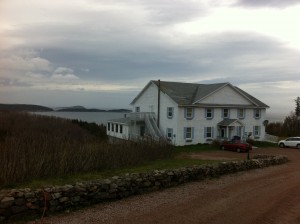
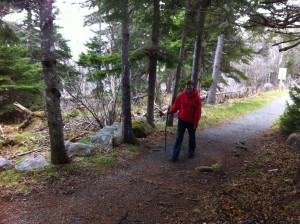
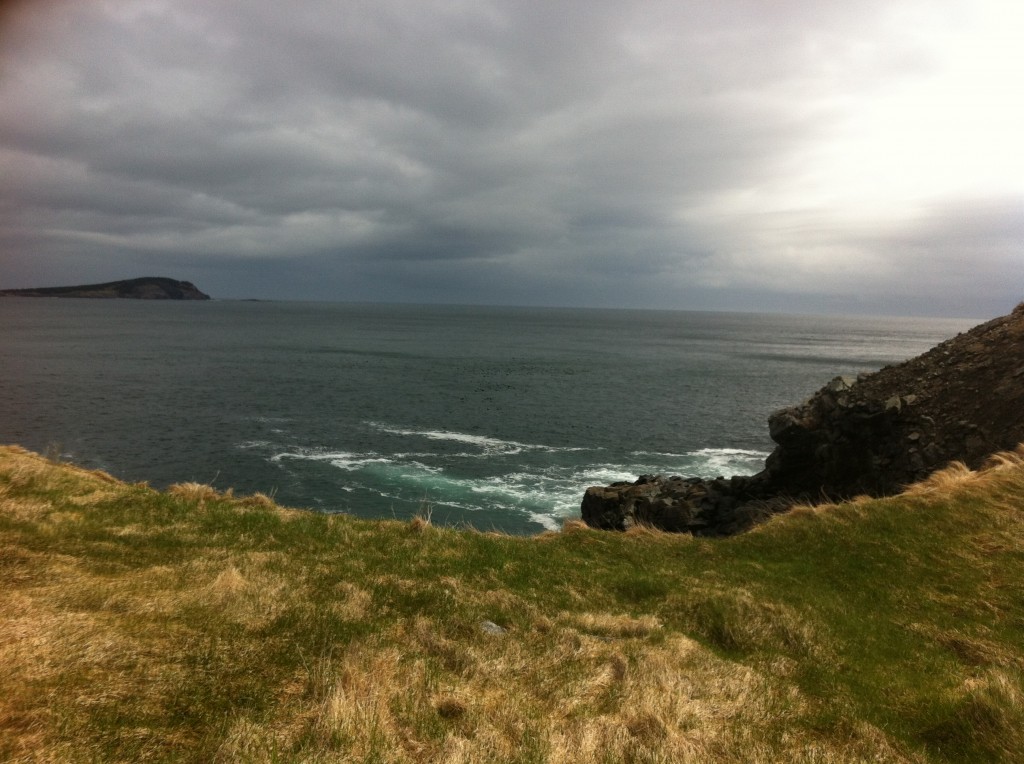

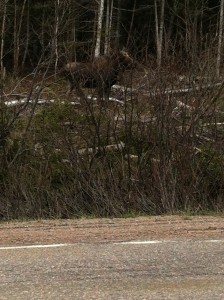

Pingback: Holiday greetings from Steve and Mimi | 2 Roads Diverged